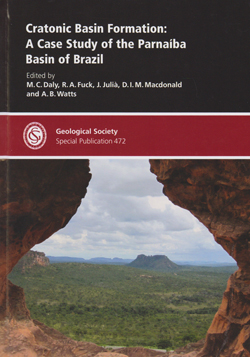
Cratonic basins—those large, roughly circular shallow depressions in the middle of continents—are one of the great unsolved mysteries of global tectonics. Why do they form and what drives their subsidence? While passive margin development is being endlessly fine-tuned using sophisticated 3D seismic datasets, cratonic basins in contrast have defied satisfactory explanation, despite covering about 10% of the world’s land area and housing significant petroleum and mineral resources. This book on Brazil’s Parnaiba Basin goes a long way towards redressing this balance.
The problem isn’t a lack of data. Many cratonic basins, for example the Williston and Michigan basins in the USA, are peppered with tens of thousands of petroleum industry wells and have been extensively studied in the field. The issue is that these data are often very specific and focused. Deep crustal and lithospheric information is scant, not least because basins of this type are characterized by very thick, cratonic-type crust and lithosphere, but also because such data have not been considered commercially relevant.
Daly and his colleagues tackle this problem head-on by assembling a consortium consisting of BP and several Brazilian and British Universities—the Parnaiba Basin Analysis Project (PBAP)—with the intention of dissecting a cratonic basin systematically from top to bottom. The result is a collection of 20 papers with comprehensive coverage including deep-lithospheric imaging and modelling, sedimentary history and architecture, magmatic history and petroleum systems. All topics are skilfully woven together in a useful introduction by the editors.
A particularly attractive aspect is that many of the papers make comparisons with other global cratonic basins in the search for common factors. It turns out there are many. Generally, the basins are geographically extensive, bowl-shaped, contain modest sedimentary thicknesses (circa 6 km) and seem to have formed and subsided in the Palaeozoic, during or just after continental consolidation. The relationship of these basins to supercontinent formation is a recurring theme, one I believe will be built upon in the coming years.
The modelling of Parnaiba and related basins provides insights into potential basin-formation mechanisms, while still leaving tantalizing loose threads. Basin evolution seems to mimic a classic thermal subsidence profile—yet there is little evidence of the preceding lithospheric extension needed to start the process. Several basins (such as the Parnaiba, Michigan and Congo basins) show gravimetric and velocity evidence of a dense, presumably magmatic body in the lower crust or upper mantle. Such a body could also trigger subsidence, but emplacement would have to just precede subsidence, and that doesn’t usually seem to be the case. The circular shape and intracontinental position of cratonic basins like Michigan and Parnaiba points seductively towards a mantle upwelling origin—a plume or suchlike. Unfortunately, the corroborating evidence isn’t there or the timing is wrong. A valiant attempt to explain the Michigan Basin by cooling of pooled material from a neighbouring “Iapetus” plume seems to require acrobatics from the putative plume, not to mention similar mental gyrations from the reader. Meanwhile, actual evidence of plume volcanism doggedly refuses to manifest itself.
The Parnaiba Basin is highly magmatic, as documented in the volume by field evidence, seismic interpretation and some stunning magnetotelluric work, which shows that the central parts of the basin are underlain by a major, highly conductive zone, attributed to magmatic impregnation of the lower crust and upper mantle. The main igneous pulses, of Early Jurassic and Early Cretaceous age, are both interpreted as part of more widespread large igneous provinces. While these episodes post-dated basin formation, and thus cannot throw light on the underlying mechanism, they are highly interesting in their own right. Not least, the heating by widespread magmatism provides a convincing explanation for the otherwise highly anomalous petroleum system of the Parnaiba Basin—dry gas resources dominating in a shallow basin with low present-day crustal heat flow.
There is a lot more that should be said about this book than is possible in this short review. Cratonic basins are going to intrigue and confound us for a while yet, but this book is a substantial step in the right direction. Importantly, it also brings these somewhat neglected basins into the geological limelight where they belong. I don’t think there is another collection remotely like this one. There are other works on specific cratonic basins, but none as generic, as well-integrated and as comprehensive.
Reviewed by Tony Doré
CRATONIC BASIN FORMATION: A CASE STUDY OF THE PARNAIBA BASIN OF BRAZIL, by M. C. Daly, R. A. Fuck, J. Julià, D. I. M. Macdonald & A. B. Watts (eds) 2018. Geological Society of London SP 472, 384 pp. ISBN: 9781786203960 (hbk.)
List price: £ 120.00
Fellow's price: £ 60.00
W: https://www.geolsoc.org.uk/SP472